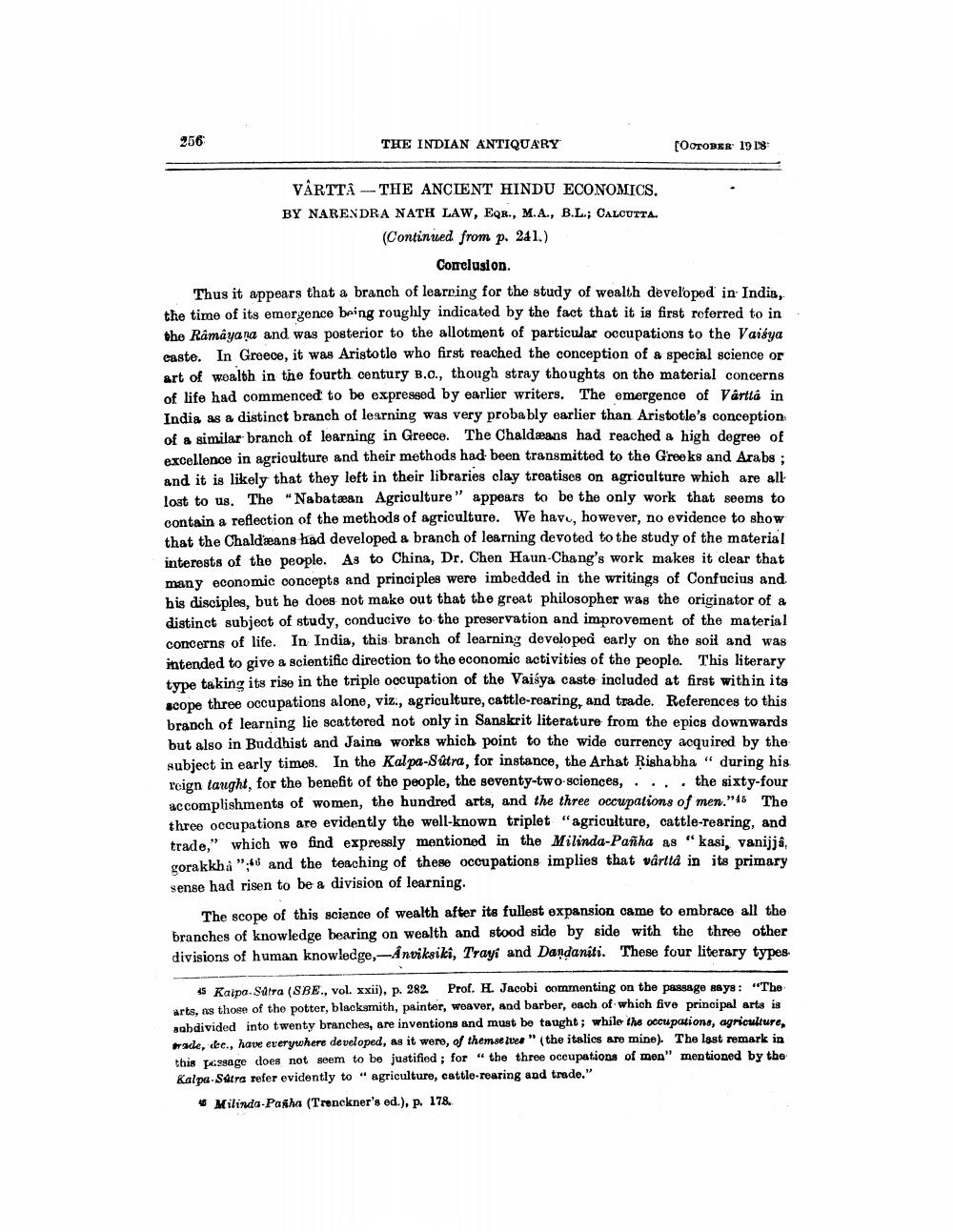________________
256
THE INDIAN ANTIQUARY
VARTTA-THE ANCIENT HINDU ECONOMICS.
BY NARENDRA NATH LAW, EQR., M.A., B.L.; CALCUTTA. (Continued from p. 241.)
Conclusion.
[OCTOBER 1918
Thus it appears that a branch of learning for the study of wealth developed in India, the time of its emergence being roughly indicated by the fact that it is first referred to in the Râmâyana and was posterior to the allotment of particular occupations to the Vaisya easte. In Greece, it was Aristotle who first reached the conception of a special science or art of wealth in the fourth century B.C., though stray thoughts on the material concerns of life had commenced to be expressed by earlier writers. The emergence of Vârttâ in India as a distinct branch of learning was very probably earlier than Aristotle's conception of a similar branch of learning in Greece. The Chaldæans had reached a high degree of excellence in agriculture and their methods had been transmitted to the Greeks and Arabs ; and it is likely that they left in their libraries clay treatises on agriculture which are all lost to us. The "Nabataan Agriculture" appears to be the only work that seems to contain a reflection of the methods of agriculture. We have, however, no evidence to show that the Chaldeans had developed a branch of learning devoted to the study of the material interests of the people. As to China, Dr. Chen Haun-Chang's work makes it clear that many economic concepts and principles were imbedded in the writings of Confucius and his disciples, but he does not make out that the great philosopher was the originator of a distinct subject of study, conducive to the preservation and improvement of the material concerns of life. In India, this branch of learning developed early on the soil and was intended to give a scientific direction to the economic activities of the people. This literary type taking its rise in the triple occupation of the Vaisya caste included at first within its scope three occupations alone, viz., agriculture, cattle-rearing, and trade. References to this branch of learning lie scattered not only in Sanskrit literature from the epics downwards but also in Buddhist and Jaine works which point to the wide currency acquired by the subject in early times. In the Kalpa-Sûtra, for instance, the Arhat Rishabha "during his reign taught, for the benefit of the people, the seventy-two-sciences,. . . . the sixty-four accomplishments of women, the hundred arts, and the three occupations of men."45 The three occupations are evidently the well-known triplet "agriculture, cattle-rearing, and trade," which we find expressly mentioned in the Milinda-Pañha as "kasi, vanijjâ, gorakkha" and the teaching of these occupations implies that vârtta in its primary sense had risen to be a division of learning.
The scope of this science of wealth after its fullest expansion came to embrace all the branches of knowledge bearing on wealth and stood side by side with the three other divisions of human knowledge,-Anviksiki, Trayi and Dandaniti. These four literary types.
45 Kaipa. Sutra (SBE., vol. xxii), p. 282. Prof. H. Jacobi commenting on the passage says: "The arts, as those of the potter, blacksmith, painter, weaver, and barber, each of which five principal arts is sabdivided into twenty branches, are inventions and must be taught; while the occupations, agriculture, rade, dec., have everywhere developed, as it were, of themselves" (the italics are mine). The last remark in this passage does not seem to be justified; for "the three occupations of men" mentioned by the Kalpa Sutra refer evidently to "agriculture, cattle-rearing and trade."
Milinda-Pasha (Trenckner's ed.), p. 178..




